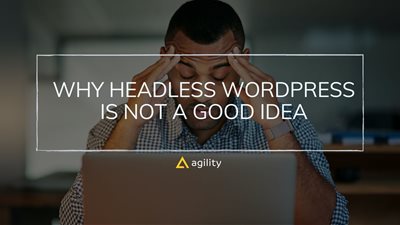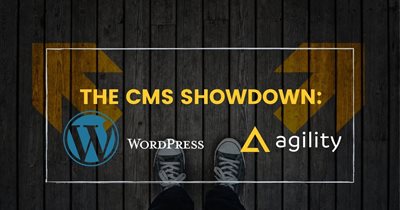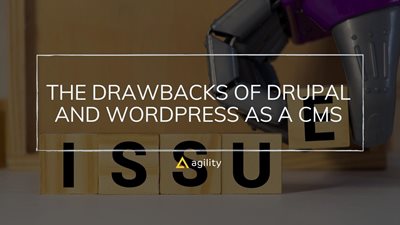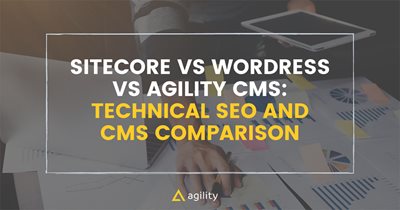Headless WordPress? Here's Why It's a Bad Idea
WordPress isn’t the best CMS solution for every company, especially if you need a headless CMS. Here are some scenarios where headless WordPress fails.


WordPress has been the dominant figure in content management since its inception in 2003.
It's undeniable that, seventeen years later, there are many reasons why WordPress is the most popular CMS on the market. With a market share of almost 40% of all websites on the internet, it's one of the powerhouses in the CMS space.
However, all that glitters isn't gold. WordPress isn't a one size fits all solution, and many companies won't benefit from using WordPress as their CMS, especially if they need headless capabilities.
In this article, we'll tell you about headless WordPress, explain why it's a bad idea, and provide some alternatives for implementation instead of going headless with WordPress.
What Is Headless WordPress?
Ever since REST API was bundled with the WordPress core in 2016, developers can experiment with it in a decoupled way, using JavaScript frameworks or libraries to write the front-end.
With a decoupled WordPress, the WYSIWYG editor is disabled, and most critical functions are managed through REST APIs instead.
The WordPress REST API returns JSON instead of HTML, giving you more flexibility around what kind of front-end you use: vanilla JavaScript, a native mobile application, a SPA, or all of the above.
While several types of sites and apps can benefit from the headless WordPress approach, WordPress comes pre-packaged with myriad options that you might not probably need, resulting in hefty performance losses.
When Headless WordPress Isn't The Best Choice For Your Project
There are a few scenarios where headless WordPress is a bad idea. These are some of them.

When You're an All-Marketers Team
If a member of the marketing team performs your website maintenance, the chances are that headless WordPress isn't the best solution for you. Since the headless architecture removes the visual interface, you will likely need someone fluent in JavaScript to maintain the site.
Also, if you don't have a web development team and rely on marketers to create new functionalities, WordPress probably isn't the best idea as your marketers will need to learn more than basic front-end code. For those that don't have the required technical skillset, it can be an unnecessarily frustrating experience.
When You're Looking for an Easy-to-Use CMS
While regular WordPress might be a good idea for many people, its headless component isn't that simple, especially if you're a marketer.
Instead, headless CMSs like Agility give you all the flexibility and simplicity you need in a low-code environment where marketers can thrive and create pages without hindrances. The truth is that going headless on WordPress might be overkill, and chances are that you're better with a headless CMS that gives you a non-gimmicky performance.

When You Rely on Plugins To Get Functionalities
Let's say you've built a WordPress site and want to go headless. It's possible that the functionalities of any plugins you've installed won't carry over to another application.
This means that if you're building omnichannel experiences, you might not be able to with WordPress. According to Aashni Shah, CEO of Elixir Labs:
"What made WordPress powerful was the numerous plugins; however, support for those plugins would randomly die or break between different versions of WordPress, and then I'd either have to find and reconfigure a replacement or look for some other alternative."
For example, static websites or PWAs need system-specific plugins and integrations, or maybe even new functionalities to be developed by a dedicated team. When you're using headless WordPress, all the functionalities of the good old WP aren't there, and you might have difficulty finding yourself at ease.
A considerable benefit of a true, headless, multi-tenant system is that it's fully managed and upgraded for you.
"This is a huge benefit because upgrading can often be a costly project, not to mention that it's not very fun either, so your team will be very happy to hear this benefit! A headless CMS like Agility CMS does not have versions. Updates are deployed continuously and automatically available to all users." - Jon Voigt, CEO of Agility CMS, explains.
When Speed Is a Must
Coupled or decoupled WordPress isn't the fastest CMS out there, and that's a fact. For instance, according to Adrian Busschaert, one of our partners at Soci Media,
"WordPress has an outdated structure and logic for the sake of maintaining compatibility with sites created many years ago. For this reason, the platform is slow, hard to customize and not secure."
Due to its nature, WordPress has always been a request-heavy CMS, which makes it clunky and sluggish when we compare it with other modern CMSs. Even if you bundle responses, it might still not be enough.
Throttling the number of requests during site generation doesn't work either, as deployment takes too long, and sites are at a subpar speed, even with proper caching.
When you are a savvy developer who needs freedom (and knows JAMstack)
Many developers use WordPress daily, but a savvy developer does not need it. You can jump right into using Jamstack and lightweight APIs and build a very flexible and lasting solution without any limitations from WordPress.
As Benji Kostenbader explained in his blog, "You Should Probably JAMstack That" (read it! you will love it!)
"WordPress plugins will quickly rack up site costs for functionality. But a one-size-fits-all solution, built to scale to any size, also adds a lot of dead weight. All the processing work for a page to render on a server quickly becomes more taxing than an API, and rarely is anything new getting done.
A savvy developer could create a lightweight, fully custom site to your specifications. But actually, there's more than that! What if your site could preload the next page's images while you read or hack the browser to stop it from reloading content it already has? That's possible with modern JavaScript frameworks like React, Angular, and Vue."
Headless WordPress vs Agility CMS
One of the problems that headless WordPress presents is that you can't count on it when it comes to your long-term development needs.
Adding Features
For instance, if you require a feature on WordPress that doesn't already exist as an add-on, plugin, or API, you'll need to hire a developer to build that.
Agility CMS is built to be an extensible platform which means you can add any feature your need or ask the Agility team to make it for you. Very often, developers tweak the venue to suit the client's needs. We help you save development time and give you a stable, lightning-fast platform where you can develop all the omnichannel experiences your customers need.
Deep down, WordPress is not a Content-First solution. Agility CMS or one of the partners will always start with offering a Content Architecture consult to ensure your CMS solution is future-proof.
In a nutshell, here is what it means to be a Content First CMS:
- This means the Website or App front-ends can be rewritten easily without changing the content in the CMS.
- This enables a future where you never have to rebuild your website from scratch.
- By starting with great Content Architecture, customers can create the proper Content Definitions with the kinds of Content Relationships that will stand the test of time.
- Content that serves as a single source of truth can be placed in a Content Warehouse so it can be made available anywhere.
- Content designed specifically for a Website, App, Line of Business, or Organizational Segment, can be placed in a Property Instance.
Also, another thing that makes Agility CMS different from a headless WordPress is the support issue.
Many people don't realize that when you're working with an open source solution, one of the most immediate problems you run into is one of support.
Open source programs aren't owned by anyone, meaning there isn't any company behind them. If you need development or support work, you and your staff will have to handle it. Traditional WordPress or Headless WordPress - these solutions don't offer any help.
You can't pick up the phone and call someone when you get stuck. If your site goes down, it's up to you and your employees to fix the problem.
Having a solid foundation of support means that if you encounter a bug or get hit with downtime, these issues will be fixed faster -- if they occur at all.
You get immediate access to the people who built the features you're experiencing issues with and know it like the back of their hands. The importance of this is something you cannot significantly put a price on when every second of downtime costs you money.

About the Author
Joel is CTO at Agility. His first job, though, is as a father to 2 amazing humans.
Joining Agility in 2005, he has over 20 years of experience in software development and product management. He embraced cloud technology as a groundbreaking concept over a decade ago, and he continues to help customers adopt new technology with hybrid frameworks and the Jamstack. He holds a degree from The University of Guelph in English and Computer Science. He's led Agility CMS to many awards and accolades during his tenure such as being named the Best Cloud CMS by CMS Critic, as a leader on G2.com for Headless CMS, and a leader in Customer Experience on Gartner Peer Insights.
As CTO, Joel oversees the Product team, as well as working closely with the Growth and Customer Success teams. When he's not kicking butt with Agility, Joel coaches high-school football and directs musical theatre. Learn more about Joel HERE.




